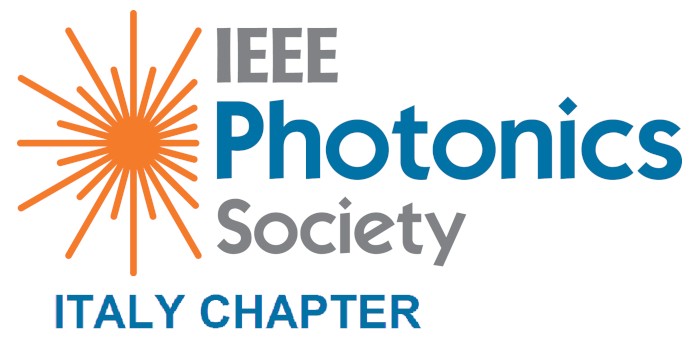Palermo, the regional capital of Sicily, is one of those cities with a very distinct, almost tangible atmosphere, a place of mystery, where reality often outperforms the traveller’s imagination and preconceived stereotypes.
Palermo’s history has been anything but stable, and the city has passed from one dominating power to another with remarkable frequency. Its strategic position at the heart of the Mediterranean brought wave upon wave of invaders, including the Phoenicians, the Carthaginians, the Greeks, the Romans, the Arabs, the Normans, the Swabians, the French, the Aragonese and the Bourbons just to name the most influential. The result of this quilted history is evident today in the vast range of architectural styles, the intriguing fusion of ingredients used in many local dishes, and in the many place names whose etymology bypasses Italian linguistic traditions.
In 2015, Arab-Norman Palermo and its neighbouring cathedrals were granted status as a UNESCO World Heritage Site. Spread over a combined 6,235 hectares and including nine monuments – the Royal Palace and Palatine Chapel, the Zisa Palace, Palermo Cathedral, the Palermitan Churches of San Giovanni degli Eremiti, Santa Maria dell’Ammiraglio and San Cataldo, the Admiral’s Bridge, and the cathedrals of Monreale and Cefalù – the site provides, in UNESCO’s words, “an outstanding example of a socio-cultural syncretism between Western, Islamic, and Byzantine cultures. This interchange gave rise to an architectural and artistic expression based on novel concepts of space, structure, and decoration that spread widely throughout the Mediterranean region… The innovative re-elaboration of architectural forms, structures, and materials and their artistic, decorative, and iconographic treatments – most conspicuously the rich and extensive tesserae mosaics, pavements in opus sectile, marquetry, sculptural elements, paintings, and fittings – celebrate the fruitful coexistence of people of different origins“.
In 2018, Palermo was both Italian Capital of Culture and host city for Manifesta12, Europe’s most prestigious itinerant festival of contemporary art.
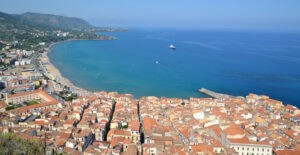
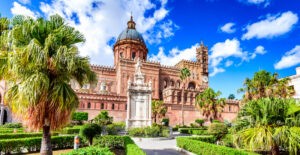
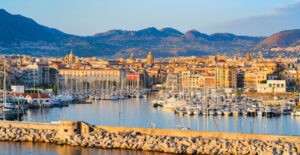

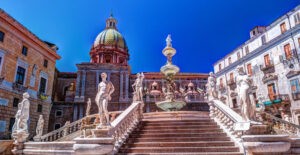
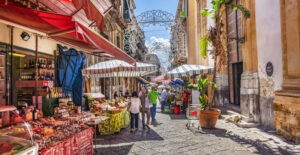
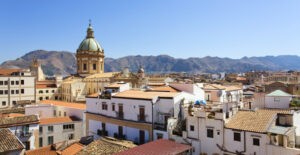
In 2015, Arab-Norman Palermo and its neighbouring cathedrals were granted status as a UNESCO World Heritage Site.
Arab-Norman Palermo and the Cathedral Churches of Cefalú and Monreale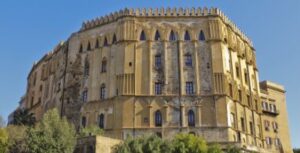 Located on the northern coast of Sicily, Arab-Norman Palermo includes a series of nine civil and religious structures dating from the era of the Norman kingdom of Sicily (1130-1194): two palaces, three churches, a cathedral, a bridge, as well as the cathedrals of Cefalú and Monreale. Collectively, they are an example of a social-cultural syncretism between Western, Islamic and Byzantine cultures on the island which gave rise to new concepts of space, structure and decoration. They also bear testimony to the fruitful coexistence of people of different origins and religions (Muslim, Byzantine, Latin, Jewish, Lombard and French).
Located on the northern coast of Sicily, Arab-Norman Palermo includes a series of nine civil and religious structures dating from the era of the Norman kingdom of Sicily (1130-1194): two palaces, three churches, a cathedral, a bridge, as well as the cathedrals of Cefalú and Monreale. Collectively, they are an example of a social-cultural syncretism between Western, Islamic and Byzantine cultures on the island which gave rise to new concepts of space, structure and decoration. They also bear testimony to the fruitful coexistence of people of different origins and religions (Muslim, Byzantine, Latin, Jewish, Lombard and French).
Designed by Roger II in 1130, this extraordinary chapel is Palermo’s top tourist attraction. Located on the mid-level of Palazzo dei Normanni’s three-tiered loggia, its glittering gold mosaics are complemented by inlaid marble floors and a wooden muqarnas ceiling, the latter a masterpiece of Arabic-style honeycomb carving reflecting Norman Sicily’s cultural complexity.
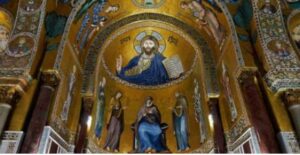
The chapel’s well-lit interior is simply breathtaking. Every inch is inlaid with precious stones, giving the space a lustrous quality. These exquisite mosaics were mainly the work of Byzantine Greek artisans brought to Palermo by Roger II in 1140 especially for this project.
They capture expressions, detail and movement with extraordinary grace and delicacy, and sometimes with enormous power – most notably in the depiction of Christ the Pantocrator and Angels on the dome. The bulk of the mosaics recount the tales of the Old Testament, though other scenes recall Palermo’s pivotal role in the Crusades. Some of the mosaics are later and less-assured additions, for instance the Virgin and Saints in the main apse under Christ the Pantocrator. Fortunately, these don’t detract too much from the overall achievement.
 The Cathedral of Palermo was founded by Gualtiero Offamilio, archbishop of the town from 1169 to 1190. It was a mosque in Islamic times and converted into a cathedral church by Roberto the Guiscardo after the conquest of Palermo. Its exclusive elements are the inlays and the architectural and sculptural plastic that reflects the penetration of Romanic art and the first Gothic decorative taste in Sicily, expanding the spectrum of the Arab-Norman syncretism with new elements in an original and multiple composition and exhibition of the Mediterranean arts.
The Cathedral of Palermo was founded by Gualtiero Offamilio, archbishop of the town from 1169 to 1190. It was a mosque in Islamic times and converted into a cathedral church by Roberto the Guiscardo after the conquest of Palermo. Its exclusive elements are the inlays and the architectural and sculptural plastic that reflects the penetration of Romanic art and the first Gothic decorative taste in Sicily, expanding the spectrum of the Arab-Norman syncretism with new elements in an original and multiple composition and exhibition of the Mediterranean arts.
 The Martorana Also Co-Cathedral of St. Mary of the Admiral is the seat of the parish of San Nicolò dei Greci, a Co-cathedral overlooking the Piazza Bellini in Palermo, Sicily, southern Italy. The church belongs to the Eparchy of Piana degli Albanesi of the Italo-Albanian Catholic Church, a diocese which includes the Albanian communities in Sicily who officiate the liturgy according to the Byzantine Rite in the ancient Greek language. The church is characterized by the multiplicity of styles that meet, because, with the succession of centuries, it was enriched by various other tastes in art, architecture and culture. Today, it is, in fact, as a church-historical monument, the result of multiple transformations, also subject to protection.
The Martorana Also Co-Cathedral of St. Mary of the Admiral is the seat of the parish of San Nicolò dei Greci, a Co-cathedral overlooking the Piazza Bellini in Palermo, Sicily, southern Italy. The church belongs to the Eparchy of Piana degli Albanesi of the Italo-Albanian Catholic Church, a diocese which includes the Albanian communities in Sicily who officiate the liturgy according to the Byzantine Rite in the ancient Greek language. The church is characterized by the multiplicity of styles that meet, because, with the succession of centuries, it was enriched by various other tastes in art, architecture and culture. Today, it is, in fact, as a church-historical monument, the result of multiple transformations, also subject to protection.
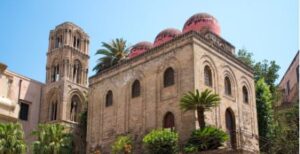 The Church of San Cataldo (1160 ca.) stands next to the church of Santa Maria dell’Ammiraglio and together with it is a monumental complex of strong attractiveness. Unlike San Giovanni degli Eremiti, which is a single hall, the church of San Cataldo has a basilica body with four columns. Through Islamic stereometrics, the use of three domes on the central axis and barrel vaults on the side bays, it translates the model of the basilica church with an original language. The absence of internal coverings makes it possible to better appreciate the architecture, the walls, the articulation of the vaults and the domes.
The Church of San Cataldo (1160 ca.) stands next to the church of Santa Maria dell’Ammiraglio and together with it is a monumental complex of strong attractiveness. Unlike San Giovanni degli Eremiti, which is a single hall, the church of San Cataldo has a basilica body with four columns. Through Islamic stereometrics, the use of three domes on the central axis and barrel vaults on the side bays, it translates the model of the basilica church with an original language. The absence of internal coverings makes it possible to better appreciate the architecture, the walls, the articulation of the vaults and the domes.
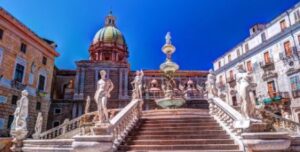 Piazza Pretoria, also known as square of Shame, is at the limits of the district of Kalsa, near the corner of Cassaro with Via Maqueda, just a few meters from the Quattro Canti, the exact center of the historic city of Palermo .
Piazza Pretoria, also known as square of Shame, is at the limits of the district of Kalsa, near the corner of Cassaro with Via Maqueda, just a few meters from the Quattro Canti, the exact center of the historic city of Palermo .
In 1573 the Senate of Palermo bought a fountain initially intended for the Palace of San Clemente in Florence, with the intention of placing it in the square.
To make way for the monumental achievement, designed for an open place, several homes were demolished and the fountain was re-adapted to the site with the addition of new parts. In 1581 the works of accommodation of the fountain on the square. The large central fountain is the focal point for sixteen nude statues of nymphs, humans, mermaids and satyrs. Since eighteenth century in 1860, the fountain was considered the representation of corrupt municipalities, and Palermo nicknamed the square with the nudity of the statues, the Square of Shame (Piazza della vergogna.) This may have also been reflecting the prevailing influence of the Spanish Inquisition during that time.











